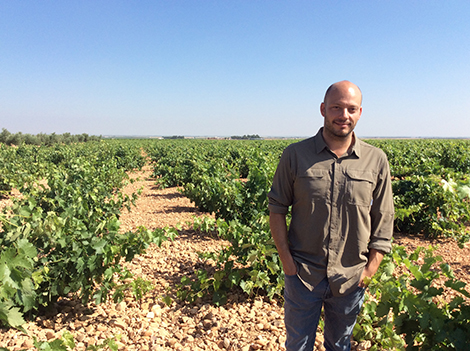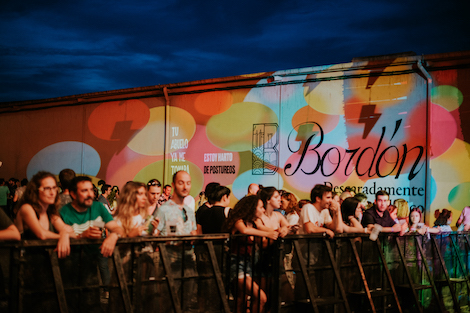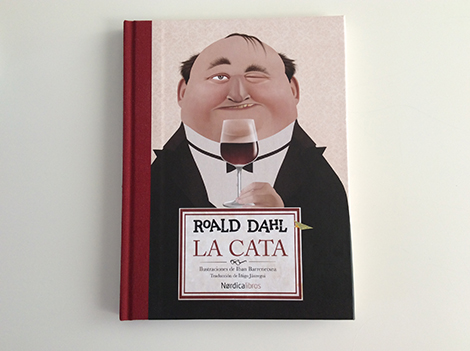
The name of the project is a small manifesto in itself. According to Elías López Montero, who also produces wine in Patagonia (Argentina) together with Hans Vinding-Diers, a cousin of Ribera del Duero’s Danish star Peter Sisseck, Verum (a Latin word that means true) implies all the genuine things about family, land and wine. For the 39-year-old winemaker, “Castilla-La Mancha has to vindicate itself and come out of the closet.”
Such an statement is easier to understand when visiting him in Tomelloso (Ciudad Real), in the heart of La Mancha. Verum’s neighbour, Virgen de las Viñas, is Europe’s largest cooperative - a gigantic city of wine that can leave many experienced wine travelers dumbstruck.
Wine, spirits, wine
Were it not for the fact that its facilities are split in different areas borrowed from Destilerías Altosa, Verum would look tiny. The family core business introduces a second, often unnoticed reality that has considerable weight in La Mancha. A considerable amount of Airén, the neutral, dominant local variety is used for distillation. Brandy producers in Jerez have been traditional buyers but international distribution has notably increased. Altosa distills between 12% and 15% of Spain’s total alcohol, is a leading exporter of wine alcohol and was the first distiller to be approved by the Instituto dos Vinhos do Porto.
Wine and spirits have been at the centre of this traditional family business since the days of patriarch José López de la Fuente in 1788, but after the sudden death of their father 22 years ago, Elías’s elder brothers decided to focus on spirits. The youngest of four children, Elías studied at the School of Vine in Madrid, finished a master degree in viticulture and marketing in Rioja and trained afterwards in Aalto (Ribera del Duero) and South Africa. By 2004 he was ready to bring back the family wine tradition.
Upon his return to Tomelloso, Elías had to deal with large plantings of Airén intended for brandy, Cencibel (aka Tempranillo) mostly suited to produce young wine and international grape varieties in relatively mature vineyards.
What to do in Castilla-La Mancha
Even if his first wine was a blend of Sauvignon Blanc and Gewürztraminer (the sole two varieties at Verum to be machine-harvested) in the 2007 vintage, his commitment to stand out and raise quality levels led him to focus on wines with ageing potential. The first choice was rather surprising: Gran Cueva 2007 (€15.11 at the winery’s online store) is a sparkling wine made with 100% Chardonnay and aged for 34 months. Elías came up with the idea after realising that the Chardonnay they were growing was not suitable to produce still wines.
The wine benefited from the impressive underground cellar (7m high and 7-8m width) built in the early 2000s to store and age spirits. On a much smaller scale, underground caves have always existed in Tomelloso thanks to the limestone rock underneath, particularly easy to dig. In fact, according to Elías, limestone soils are the area’s major quality asset.
The most widely available wine right now is Verum, a red blend of Tempranillo and international grapes (around €10 in Spain). Elías favours a prominent role for Merlot (around 60% of the blend): “It adds elegance to the wine and grows well in the limestone soils we have,” he explains. The current 2012 vintage appears balanced with pleasant fruit and texture, but the 2008 has developed seamlessly. It might not the style now favoured by many wine aficionados, but the image of the whole region would undoubtedly improve if there were more wines in La Mancha with such consistence and drinkability.
Verum (250,000 bottles) is the brand used for the family’s classic range of wines. It includes an entry-level Roble, a Reserva de la Familia Tempranillo that is released after several years of bottle aging and various single-varietal wines sold for under €21 in Spain. They draw upon those days in which most Spanish regions enthusiastically planted the so called “variedades mejorantes” (improving varieties), most of which are planted in Finca Los Arcángeles, a 40Ha vineyard with shallow limestone soils. Additionally, Verum is based on quality (low yields), sustainable (organically certified vineyards since 2013) and respectful (natural yeasts) criteria.
Tinto Velasco, an obscure local variety
With the same extension under vine as Los Arcángeles and similar soils, Finca Romeral is markedly different. It was planted with late ripening, rustic, drought-resistant varieties capable to “cope with forthcoming challenges like climate change and water shortage,” says López Montero. The choice of grapes took into account several studies conducted by the IVICAM, Castilla-La Mancha’s Vine and Wine Research Center.
Surprisingly enough, Malvasía was the first variety to show its potential (it’s really rare to grow it so far away from the sea, even if the plants were brought from La Palma in the Canary Islands). After a quick press to avoid any bitterness from the skins, the cloudy must is fermented and racked several times. While the 2017 vintage is not particularly aromatic, I loved the exotic and fragrant 2016 (dried herbs, rosemary, curry) which also showed the variety’s fantastic acidity.
If there is a star red variety, that is Tinto Velasco. It has real punch and energy on the glass: lively cherry and blackberry aromas followed by lots of freshness. Elías loves its structure and acidity even if he says that Cariñena’s acidity is higher. He also notes that green, unripe berries are quite common with Tinto Velasco. The research by IVICAM concluded that this local variety (there are around 3,000 Ha under vine in Castilla-La Mancha but it is rarely bottled as a single varietal) is particularly drought-resistant, gives good color and can produce interesting wines. Weak points are its high yields (limits are crucial) and its tendency to be affected by millerandage.
Tinto Velasco is part of the new Ulterior range of wines (it means beyond). Labels indicate the grape variety and the plot it is sourced from as in Ulterior Tinto Velasco Parcela Nº 10 2016 (7,500 bottles, €19 at the winery’s online store). This wine includes 5% of destemmed stalks and has been aged in a mix of traditional and cube-shaped barrels (the latter is an invention patented by the family and used both for wines and spirits) together with clay-jars locally called tinajas.
“We want to use tinajas in all of the wines because they are very traditional in our region and can add some mineral aromas to the wines,” Elías says. Most of these big-sized jars have been recovered in pristine conditions from his grandparents’ cellars thanks to the fact that they used to store alcohol in them.
I particularly also liked Ulterior Garnacha which is set to be released in a few months. Aged entirely in clay jars and made with 70% of whole bunches, it is refreshing and herbal and offers the right mix of exuberance and smoothness. Isn’t it incredible to find such an attractive, even sophisticated style in Tomelloso?
The Cariñena, labelled as Ulterior Mazuelo (another of the names of this variety), felt more ripe and extracted (could this be because it has been exclusively aged in barrels?) but the Graciano (9,000 bottles, €19, aged in clay jars except for 10% in oak) was again delightful and fresh. Juicy and expressive, it displayed juicy red fruit and perhaps less herbaceous notes than others made in Rioja, yet it retained some green nuances that Elías described as fig leaves.
The harsh truth
Could these novel wines set a trend in the area? Right now, Verum seems to stand in isolation in one of Spain’s less dynamic wine areas. “There are no projects of any kind focused on quality,” Elías admits.
In a way, it is understandable, explains the young winemaker. “Many families make a very decent living with wine, but if we want people worldwide to look at Castilla-La Mancha with new eyes, we must offer a new perspective and many things need to be improved.”
Yields are particularly worrying. IGP Castilla, the seal chosen by Verum to sell its wines except for its Gran Cueva sparkling, sets a maximum of 10,000 kg/ha for goblet vines and 14,000 kg/ha for trellised vineyards. “This is like saying: 'let's produce an awful lot of Sauvignon Blanc or green Merlot that will be later fixed in the winery'”, Elías points out. “The truth is that low yields aren’t profitable for cooperatives given the price* they are paid for grapes, but we have other productive categories like table wines with no limits at all or varietal wines where yields can reach 30,000 kg/ha. My question is: where are the limits for producers working on the three levels?”
In this context, it is rather scary to see that the region is studying recent proposals to set IGP’s yields at 25,000 kg/ha. For Elías, the main worry for Castilla-La Mancha should be “to reorganize production and the industry in order to clearly separate between distillation and bulk, entry-level and premium wines”, he explains. “Certain types of wines should not be allowed and vineyards should be planted based on the type of wine they are destined to. Quality, low-yield wines should be clearly differentiated from the rest."
Is there a future for Airén?
With his international background, a second project in Argentina and on his first year as MW candidate, no doubt Elías has a global perception of wine. “We must look to areas like Maule (Chile), Swartland (South Africa), Barossa Valley and Mornington Peninsula in Australia and many others. I like to keep abreast of what’s going on in regions that have similarities with La Mancha, but also is colder areas. I love Australia as a producing country but also for their mentality; they are tremendously dynamic.”
That is probably why he doesn’t give up the arduous task of finding ways to get the best out of Airén. “It’s pointless to insist on fermenting whites made with such a neutral variety that instead expresses the soil well,” argues Elías. Using natural yeasts and without looking for non-existent aromas, he produces a fairly neutral, medium-bodied white with some briny notes on the finish that could be compared with some dry, young Palomino and Pedro Ximénez whites from southern Spain (are we about to establish a ‘neutral white’ category in Spain?).
Grapes for this wine are sourced from the family’s oldest, ungrafted vineyards planted in 1950 on stony soils. These creeping vines form a perfect umbrella-shaped canopy that protects grapes from the sun (see photo above). Oddly enough, this wine is mainly sold on the local/regional market and in Japan where it can be seen in the wine lists of sea-food and oyster bars and restaurants.
Although Elías is currently working on a premium Airén he acknowledges that he is grafting some of these vines with the most exciting varieties from Finca Romeral like Garnacha and Graciano.
“More Quixotes are needed in this land!,” proclaims Elías. Who would disagree?
*Representative prices of grapes in Castilla-La Mancha in the 2017 vintage provided by Elías López Montero
Airén: €0.30 compared to €0.24 in a standard year.
Tempranillo: €0.35, but usually lower in highly productive years
Chardonnay: €0.45 due to heavy demand in 2017
Cabernet Sauvignon/Merlot/Syrah: €0.38

Amaya Cervera
A wine journalist with almost 30 years' experience, she is the founder of the award-winning Spanish Wine Lover website. In 2023, she won the National Gastronomy Award for Gastronomic Communication
Summer readings over a glass of wine
NEWSLETTER
Join our community of Spanish wine lovers






